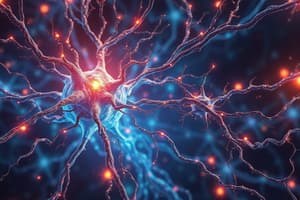Podcast
Questions and Answers
Which structural classification of neurons looks like it has no axon?
Which structural classification of neurons looks like it has no axon?
- Unipolar
- Bipolar
- Anaxonic (correct)
- Multipolar
Which of the following is a functional classification of neurons? (Select all that apply)
Which of the following is a functional classification of neurons? (Select all that apply)
- Glial Cells
- Interneurons (correct)
- Motor Neurons (correct)
- Sensory Neurons (correct)
What are sensory neurons also known as?
What are sensory neurons also known as?
Afferent Neurons
What is the primary function of motor neurons?
What is the primary function of motor neurons?
Where are interneurons found?
Where are interneurons found?
What is the role of glial cells?
What is the role of glial cells?
Which is NOT a type of glial cell in the CNS?
Which is NOT a type of glial cell in the CNS?
What do oligodendrocytes form?
What do oligodendrocytes form?
What is the thick, dense connective tissue layer enclosing a nerve called?
What is the thick, dense connective tissue layer enclosing a nerve called?
The cell body of a mature neuron contains a centriole.
The cell body of a mature neuron contains a centriole.
What type of neuron is functionally classified as a visceral motor neuron?
What type of neuron is functionally classified as a visceral motor neuron?
A myelinated axon conducts impulses ____ than an unmyelinated axon.
A myelinated axon conducts impulses ____ than an unmyelinated axon.
In terms of nerve impulse conduction, unmyelinated is to ____________ as myelinated is to ____________.
In terms of nerve impulse conduction, unmyelinated is to ____________ as myelinated is to ____________.
Oligodendrocytes release a nerve growth factor to stimulate axonal outgrowth.
Oligodendrocytes release a nerve growth factor to stimulate axonal outgrowth.
What helps to protect and support neurons?
What helps to protect and support neurons?
Where are neurolemmocytes found?
Where are neurolemmocytes found?
Interneurons are organized into neuronal pools.
Interneurons are organized into neuronal pools.
What do ependymal cells help produce in the CNS?
What do ependymal cells help produce in the CNS?
Flashcards are hidden until you start studying
Study Notes
Nervous Tissue Overview
- Neurons classified structurally as anaxonic (no axon), unipolar (one process), bipolar (rare, found in the retina), and multipolar (most common type).
- Neurons also classified functionally as sensory (afferent), motor (efferent), and interneurons.
Sensory Neurons
- Afferent neurons transport information from the body to the CNS, detecting environmental changes.
- Typically unipolar or some bipolar in structure.
Motor Neurons
- Efferent neurons transmit impulses from the CNS to muscles or glands.
- Most are multipolar in structure.
Interneurons
- Exclusively located in the CNS; facilitate communication between motor and sensory neurons.
- Generally multipolar.
Glial Cells
- Smaller cells that do not transmit impulses but support neurons and maintain nervous tissue structure.
- Capable of mitosis and divide to assist in maintaining neuron function.
Types of Glial Cells in the CNS
- Astrocytes: Most abundant, contact neurons and capillaries, form blood-brain barrier, control electrolyte concentration, and can replace damaged neurons.
- Ependymal Cells: Line brain and spinal cord cavities, possess cilia, and assist in producing and circulating cerebrospinal fluid (CSF).
- Microglia: Least common type; phagocytize debris and pathogens, acting as the immune defense in the CNS.
- Oligodendrocytes: Form myelin sheath, insulating CNS axons, and facilitating rapid conduction of impulses.
Glial Cells in the PNS
- Satellite Cells: Support unipolar neurons in dorsal root ganglia.
- Neurolemmocytes (Schwann Cells): Produce myelin sheath for PNS axons.
Nodes of Ranvier
- Non-myelinated gaps between Schwann Cells on axons, crucial for impulse transmission.
Unique Neuron Characteristics
- Neurons have electrical conductivity, extreme longevity, do not divide, and have a high metabolic rate, requiring oxygen and nutrients.
Major Functions of the Nervous System
- Sensory Input: Gathering information.
- Integration: Processing and evaluating information.
- Motor Output: Generating responses to information.
Nerve Impulse Conduction
- Myelinated axons conduct impulses faster than unmyelinated ones; larger diameter axons further increase conduction speed.
- Unmyelinated axons transmit impulses continuously, while myelinated axons conduct impulses via saltatory conduction.
Nerve Structure
- Nerves consist of bundles of parallel axons surrounded by three connective tissue layers: endoneurium (single axon), perineurium (fascicle), and epineurium (all fascicles together).
Regeneration
- CNS axon regeneration is limited due to several factors including: lack of nerve growth factor from oligodendrocytes, the complexity of crowded axons, and obstructive scar tissue from astrocytes.
- PNS axon regeneration is influenced by damage extent, nerve growth factor secretion, and distance to the effector organ.
Synapses
- Chemical synapses rely on receptor proteins located only on the postsynaptic membrane.
- Synapses can be classified based on the point of contact and transmission method.
Additional Facts
- Neurons cannot divide and are considered terminally differentiated.
- Receptors collect sensory information and ependymal cells produce CSF.
- Neurolemmocytes are essential for nerve damage repair in the PNS.
- Structural classes of neurons (unipolar and bipolar) are primarily sensory in function, while interneurons are exclusive to the CNS.
Studying That Suits You
Use AI to generate personalized quizzes and flashcards to suit your learning preferences.




